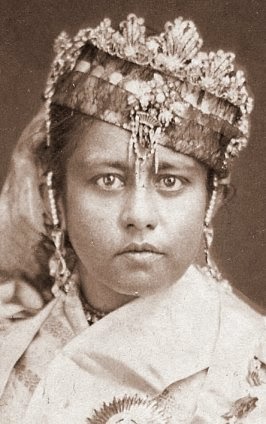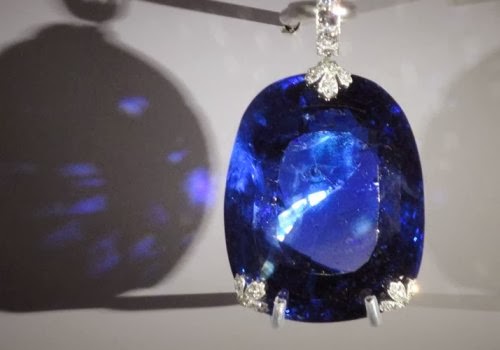 |
| Virginia Coventry, Viscountess Deerhurst [1] |
The Imperial Order of the Crown of India
 |
| Badge of the Imperial Order of the Crown of India [1] |
 |
| Queen Victoria, ca. 1882 [2] |
 |
| Nawab Shahjihan Begum of Bhopal, ca. 1872 [4] |
Eight royal Indian women were also among the original membership of the order. Maharani Bamba, something of a real-life Cinderella, was the wife of the last Maharaja of Lahore. Nawab Shahjihan Begum was the ruler of Bhopal in her own right; her elderly grandmother, Nawab Kudsia Begum, was also made a companion. Maharani Vani Vilasa Sannidhana Kempananja Ammani Avaru was the wife of one Maharaja of Mysore and the mother (and regent) of another. Maharini Jamnabai Sahib Gaekwad, the widow of the Maharaja of Baroda, was also the adopted mother of a subsequent Baroda ruler. Sahebzadi Dialwar unisa Begum Saheba was the grandmother of the Nizam of Hyderabad. Vijaya Mohenu Mukta Boyi was the daughter of the last Raja of Tanjore, and some recognized her as her father’s successor. Maharani Swarnamoyee of Cossimbazar was renowned for her charity work.
Seventeen additional women, all related to the past and present colonial officials in India, were also recognized as original companions of the order. The Dowager Countess of Elgin, Lady Mayo, Lady Susan Bourke, Lady Jane Baring, Lady Lytton, Lady Lawrence, and Lady Strachey were all wives, widows, or daughters of Viceroys and Governors-General of India. Lady Mary Temple-Nugent-Brydges-Chandos-Grenville, Lady Hobart, Lady Napier, and Lady Denison were all wives or daughters of Governors of Madras. Lady Frere and Lady Temple were wives of Governors of Bombay. Viscountess Halifax’s husband was in charge of the British East India Company. Lady Salisbury, Lady Ripon, and Lady Northcote were wives of Secretaries of State and (Under-Secretaries of State) of India.
Over the next seventy years, many more British princesses, Indian royals, and relatives of colonial officials were added to the order’s ranks. In 1947, when British colonial control of India ended, the order was essentially suspended; as you can imagine, there’s been no need to add new companions to an imperial order of chivalry based in a country that has since gained its independence.
Today, there is exactly one living person who was invested as a member of the order during its tenure: Queen Elizabeth II, who was made a companion on June 12, 1947. Her sister, Princess Margaret, was made a companion of the order on the same day, even though she was only sixteen. (You can see Margaret wearing the insignia of the order in this portrait; it is placed on her left shoulder, above her family orders.) Both of the princesses were appointed to the order during the celebrations of the official birthday of their father, King George VI [5]. India gained independence from Britain two months later, on August 15, 1947.
Cartier: Style and History
 |
| On display for the first time: a sapphire worn by Queen Marie of Romania at her coronation [1] |
 |
| The Williamson diamond brooch [4] |
The pieces loaned to the exhibition by Queen Elizabeth II have been seen by the public on a much more regular basis. One is the phenomenal Williamson brooch (pictured at right), which features one of the most valuable pink diamonds in the world. The diamond, which weighs more than 23 carats, was given to the queen by John Williamson as a wedding present in 1947 [5]. Cartier designed the brooch to complement the stone five years later. Unfortunately, Suzy Menkes says that the exhibit does not display the piece to its greatest effect, because the “low lighting does not do this rose pink stone justice” [6]. The other piece loaned by Elizabeth to the exhibit is perhaps even more recognizable: it’s the Halo tiara that the Duke of York (later George VI) purchased for his wife from Cartier in 1936. We know it better today as the Duchess of Cambridge’s wedding tiara [7]. The curators of this exhibition knew to capitalize on that famous connection; Kim Willsher explains, “To ensure its significance did not go unremarked, there was a framed photograph of Kate, Duchess of Cambridge, wearing the Halo diadem – ‘something borrowed’ from the Queen – at her wedding to Prince William in 2011” [8].
 |
| Diamond tiara once owned by Queen Elisabeth of Belgium [9] |
But Kate’s wedding tiara isn’t the only diadem in the exhibition that has connections to royalty. Doulton reports that “one of the first cases displays a revolving carousel of diamond tiaras that shower out sparkles of light and revolve just slowly enough to take in their delicate grace,” marveling that it makes the viewer feel like her or she is “standing pressed against the wall at a ball during the height of the Belle Époque” [10]. One of these sparklers is the diamond and platinum bandeau (pictured above) acquired from Cartier by Queen Elisabeth of the Belgians in 1912. The tiara was worn by Elisabeth at several major royal occasions, including the weddings of her son and grandson. It was eventually sold back to Cartier by Princess Lilian, Elisabeth’s daughter-in-law, in 1987 [11].
 |
| The Essex tiara [12] |
And there are plenty of other tiaras with royal connections, too. The Essex tiara (pictured above), made for a countess and later worn by the wife of a prime minister (that’d be Lady Churchill) and a crown princess (Margarita of Romania), is on display [13]. So are two tiaras from the collection of Marie Bonaparte, including her olive wreath tiara [14].
 |
| The Windsor flamingo brooch [16] |
As you might expect, there are a number of objects included in the exhibition that were worn by Princess Grace of Monaco. The Grimaldis have loaned Grace’s engagement ring, an impressive diamond and platinum necklace, several animal brooches, and the three brooches that make up the Bains de Mer tiara [15]. And another pair of famous royal Cartier customers, the Duke and Duchess of Windsor, are represented by several jewels. The duke’s grandfather, Edward VII, famously dubbed Cartier “the jeweler of kings,” and although David abandoned his throne, he continued to patronize the jeweler as if he were still a sovereign. Among the duchess’s jewels on display are her famous flamingo brooch (pictured at right) and one of her diamond panthers, this one perched on an enormous cabochon sapphire. Jewels from other American collectors like Gloria Swanson, Elizabeth Taylor, and Barbara Hutton sparkle throughout as well.
 |
| The Patiala bib necklace [17] |
But it’s a jewel that belonged to a male customer, not a woman, that perhaps steals the entire show. Cartier has loaned a restored version of the famous Patiala necklace (pictured at left) to the exhibition. Ordered from Cartier in 1928 by Bhupinder Singh, the Maharaja of Patiala, this bib necklace originally featured the yellow De Beers diamond in its pendant element. That diamond alone weighed more than 234 carats; the restored version of the necklace features a replica stone in its place (along with other replacement stones throughout). Doulton marvels that the “jaw-dropping” necklace, which features diamonds “the size of conkers,” is able to be “seen from across the vast room” [18]. The necklace was discovered in pieces in 1998, identified as Cartier, and restored.
The exhibition is being held at the Grand Palais, located on the Avenue de Champs-Élysées, until February 16, though it is closed on Tuesdays. Much more is available at the exhibition’s website. But if you, like me, can’t make it to Paris to see these remarkable gems before the show closes in a few weeks, there’s another alternative available. An iPad app, which features gorgeous, high-definition photos of many of the famous royal gems in the exhibition, is available for $3.99. Its text is in English, and it’s quite a bit cheaper than a round-trip ticket to France!
A note: special thanks to reader Nancy, who was lucky enough to visit the exhibition, for sending me the gorgeous photographs in this post and giving me permission to use them on the blog. Thank you so much!
NOTES, PHOTO CREDITS, AND LINKS
1. Photograph taken by blog reader Nancy. Used with the kind permission of the photographer. Do not reproduce without the photographer’s consent.
12. Photograph taken by blog reader Nancy. Used with the kind permission of the photographer. Do not reproduce without the photographer’s consent.
16. Photograph taken by blog reader Nancy. Used with the kind permission of the photographer. Do not reproduce without the photographer’s consent.
17. Photograph taken by blog reader Nancy. Used with the kind permission of the photographer. Do not reproduce without the photographer’s consent.
18. See the Telegraph review of the Cartier exhibition here.